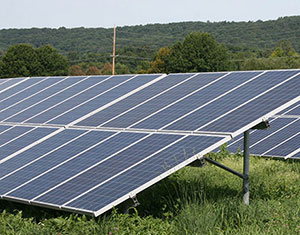Economic Sustainability
With rising energy costs, energy efficiency and sustainable development practices become important considerations for all of us. Future economic development in the County will include Green businesses and energy efficiency programs.
Importance of Economic Sustainability
 Many Americans are looking towards emerging "green" jobs to help stimulate the economy and create employment opportunities.1 Depending on future government policies, the economic impact of the green construction market can be substantial: a 2009 U.S. Green Building Council study found that the economic impact of the green construction market on the nation's gross domestic product was $173 billion during 2000-2008, and anticipated that it would increase to $554 billion from 2009-2013. This included an increase from 2.4 million jobs to 7.9 million jobs during the same period. The study also anticipated that the overall green construction market is expected to generate $6 billion in energy savings.2 In addition, the "Pennsylvania Green Jobs Report, Part I" the Center for Workforce Information & Analysis defined green jobs by identifying 81 Standard Occupational Classification codes that corresponded with the green industries identified through the North American Industry Classification System.3
Many Americans are looking towards emerging "green" jobs to help stimulate the economy and create employment opportunities.1 Depending on future government policies, the economic impact of the green construction market can be substantial: a 2009 U.S. Green Building Council study found that the economic impact of the green construction market on the nation's gross domestic product was $173 billion during 2000-2008, and anticipated that it would increase to $554 billion from 2009-2013. This included an increase from 2.4 million jobs to 7.9 million jobs during the same period. The study also anticipated that the overall green construction market is expected to generate $6 billion in energy savings.2 In addition, the "Pennsylvania Green Jobs Report, Part I" the Center for Workforce Information & Analysis defined green jobs by identifying 81 Standard Occupational Classification codes that corresponded with the green industries identified through the North American Industry Classification System.3
Total energy consumption on a national basis (as measured in BTUs) increased over the last quarter century by nearly 25 percent, from 76.5 quadrillion BTUs in 1985 to 94.6 quadrillion BTUs in 2009. Conversely, domestic production of fossil fuels decreased slightly from 57.5 quadrillion BTUs to 57.0 quadrillion BTUs over the same period. The net importation of energy increased by 300 percent during this period; from 7.6 quadrillion BTUs in 1985 to 22.8 quadrillion BTUs in 2009. This indicates that substantial costs are associated with the importation of foreign-sourced energy supplies, which are paid by consumers in the form of dollars that are sent overseas. For example, the U.S. imported about 52 percent of the crude oil that it used,4 while oil prices rose to a two-year high in November, 2010 — approaching $90 per barrel. This trend may be assumed to continue for the foreseeable future.5
Energy conservation practices and sustainable development activities can help reduce energy costs, which have a direct and positive effect on business profitability and on homeowners' budgets. Many of the practices and suggestions in this website can be implemented with little or no up-front cost, or can be quickly paid for by energy savings.
There is no shortage of innovations in the "green" industrial sector, and they range from activities that are still in the research and development stage to more established and applied technologies. In Chester County, we can probably anticipate an increased use of solar power, geothermal systems, wind turbines, biomass-based energy systems and electric vehicles. This includes an increased use of the U.S. Building Council's LEED (Leadership in Energy and Environmental Design) certified buildings and other energy-focused standards such as the "Passiv-Haus" system, In addition, we will probably witness the increased use of building techniques that were considered exotic not too long ago, but which are now becoming part of conventional construction techniques such as very high R-value insulation materials, efficient lighting fixtures, the use of recycled building materials, solar orientation and thermal massing, and rooftop photovoltaic systems. We should also strive for achieving efficiency not only in our building techniques, but in where we build: we should focus on building homes and businesses in areas that can take advantage of existing utilities, transportation systems, and community facilities rather than continuing to build outwards with sprawl developments.
Economic Sustainability | Environmental Sustainability | Social Sustainability
1 Izzo, Phil. "Can Green Jobs Save the Economy?" The Wall Street Journal Digital Network, December 21, 2010
2 U.S. Green Building Council Green Jobs Study (November 11, 2009)
3 The Pennsylvania Green Jobs Report, Part I the Center for Workforce Information & Analysis, provided by the Smart Energy Initiative of Southeastern PA for the Sustainable Business Network of Greater Philadelphia (January 4, 2011).
4 "Primary Energy Overview," U.S. Energy Information Administration Independent Statistics and Analysis (December 21, 2010)
5 "Oil prices march on, New York crude at two-year high" (November 9, 2010)

